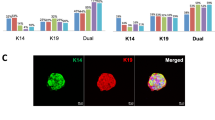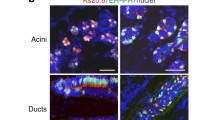Summary
The factors involved in estradiol-17β induced growth stimulation of MCF-7 human breast cancer cells have been examined. Wild type MCF-7 cells (and clone E3) were shown to undergo slow growth in phenol-red-free medium containing specific calf sera. The E3 clone was used to document a mean 6-day growth stimulation of 3.35-fold (doubling time=33±3 h) in cultures supplemented with 10−11 M estradiol-17β. The serum batch utilized in the culture medium is most important in acquiring significant growth stimulation of MCF-7 cells by estradiol-17β. Regardless of the absence of phenol-red, only selected sera (2 out of 14 tested) supported minimal growth of MCF-7 cells in the absence of added estradiol 17β (doubling time=55±11 h). When a calf-serum-supplemented culture failed to display a complete growth response to estradiol-17β, it was due to the rapid growth of the cells in the control (minus estradiol-17β) flasks. Sera that promoted shorter doubling times for MCF-7 cells cultured in the absence of estradiol-17β were rendered less supportive of growth if treated with dextran-coated charcoal or when cultures were supplemented with the estrogen antagonist ICI 164,384 (10−7 M). Pooled extracts of these sera were shown to contain stimulatory levels of estradiol-17β. Dextrancoated charcoal treatment of sera removed or deactivated factors (other than estradiol-17β) which were not only required for the growth of MCF-7 cells, but were necessary for estrogen-stimulated growth. Varying the serum-containing medium, buffer, and nutrient mix or the addition of insulin has no effect on the growth response of these cells to estradiol-17β. These investigations document the culture conditions required to produce a maximal and consistent proliferative effect of E2 on MCF-7 cells without exposing the serum constituent to damaging chemical or absorbent agents.
Similar content being viewed by others
References
Aakvaag, A.; Utaaker, E.; Thorsen, T., et al. Growth control of human mammary cancer cells (MCF-7 cells) in culture: effect of estradiol and growth factors in serum-containing medium. Cancer Res. 50:7806–7810; 1990.
Aitken, S. C.; Lippman, M. E.; Kasid, A., et al. Relationship between the expression of estrogen-regulated genes and estrogen-stimulated proliferation of MCF-7 mammary tumor cells. Cancer Res. 45:2608–2615; 1985.
Areteaga, C. L.; Coronado, E.; Osborne, C. K. Blockage of the epidermal growth factor receptor inhibits transforming growth factor-a-induced but not estrogen-induced growth of hormone-dependent human breast cancer. Mol. Endocrinol. 2:1064–1069; 1988.
Bates, S. E.; Davidson, N. E.; Valverius, E. M., et al. Expression of TGFα and its mRNA in human breast cancer: its regualtion by estrogen and its possible functional significance. Mol. Endocrinol. 2:543–555; 1988.
Berry, M.; Metzger, D.; Chambon, P. Role of the two activating domains of the estrogen receptor in the cell-type and promoter-context dependent agonistic activity of the anti-estrogen 4-hydroxy tamoxifen. EMBO J. 9:2811–2812; 1990.
Bethosis, Y.; Katzenellenbogen, J. A.; Katzenellenbogen, B. S. Phenol red in tissue culture media is a weak estrogen: implications concerning the study of estrogen-responsive cells in a culture. Proc. Natl. Acad. Sci. USA 83:2496–2500; 1986.
Brooks, S. C.; Horn, L.; Horwitz, J. P. The conjugation of estrogen metabolites by liver slices. Biochem. Biophys. Acta 104:250–260; 1965.
Brooks, S. C.; Wappler, N. L.; Corombos, J. D., et al. Estrogen structure-receptor function relationships. In: Moudgil, V. K., ed. Recent advances in steroid hormone action. Berlin: Walter de Gruyter and Co.; 1987:443–466.
Brown A. M. C.; Jeltsch, J. M.; Roberts, Z. M., et al. Activation of pS2 gene transcription is a primary response to estrogen in the human breast cancer cell line MCF-7. Proc. Natl. Acad. Sci. USA 81:6344–6348; 1984.
Butler, W. B. Preparing nuclei from cells in monolayer cultures suitable for counting and for following synchronized cells through the cell cycle. Anal. Biochem. 141:70–73; 1984.
Butler, W. B.; Berlinski, P. J.; Hillman, R. M., et al. Relation ofin vivo properties to tumorigenicity for a series of sublines of the human breast cancer cell line MCF-7. Cancer Res. 46:6339–6348; 1986.
Butler, W. B.; Kelsey, W. H.; Goran, N. Effects of serum and insulin on the sensitivity of the human breast cancer cell line MCF-7 to estrogen and antiestrogens. Cancer Res. 41:82–88; 1981.
Butler, W. B.; Kirkland, W. L.; Gargala, T. L., et al. Steroid stimulation of plasminogen activator production in a human breast cancer cell line (MCF-7). Cancer Res. 43:1637–1641; 1983.
Clarke, R.; Brunner, N.; Katz, D., et al. The effects of a constitutive expression of transforming growth factor-α on the growth of MCF-7 human breast cancer cellsin vitro andin vivo. Mol. Endocrinol. 3:372–380; 1989.
Darbre, P. D.; Daly, R. J. Effects of oestrogen on human breast cancer cells in culture. Proc. R. Soc. Edinb. 95B:119–132; 1989.
Darbre, P.; Yates, J.; Curtis, S., et al. Effects of estradiol on human breast cancer cells in culture. Cancer Res. 43:349–354; 1983.
Dell’Aquila, M. L.; Pigott, D. A.; Bonaquist, D. L., et al. A factor from plasma-derived human serum that inhibits the growth of the mammary cell line MCF-7: characterization and purification. JNCI 72:291–298; 1984.
Dembinski, T. C.; Leung, C. K. H.; Shiu, R. P. C. Evidence for a novel pituitary factor that potentiates the mitogenic effect of estrogen in human breast cancer cells. Cancer Res. 45:3083–3089; 1985.
Devleeschouwer, N.; Legros, N.; Olea-Serrano, N., et al. Estrogen conjugates and serum factors mediating the estrogenic trophic effect on MCF-7 cell growth. Cancer Res. 47:5883–5887; 1987.
Edwards, D. P.; Adams, D. J.; Savage, N., et al. Estrogen induced synthesis of specific proteins in human breast cancer cells. Biochem. Biophys. Res. Comm. 93:804–812; 1980.
Hagino, Y.; Mawatari, M.; Yoshimura, A., et al. Estrogen inhibits the growth of MCF-7 cell variants resistant to transforming growth factor-beta. Jpn. J. Cancer Res. 79:74–81; 1988.
Higuchi, K.; Robinson, R. C. Studies on the cultivation of mammalian cell lines in a serum-free chemically defined medium. In Vitro 9:114–121; 1973.
Iacobelli, S.; Scambia, G.; Natoli, V., et al. Estrogen stimulates cell proliferation and the increase of a 52 000 dalton glycoprotein in human breast cancer cells. J. Steroid Biochem. 20:747–752; 1984.
Johnson, M. D.; Westley, B. R.; May F. E. B. Estrogenic activity of tamoxifen and its metabolites on gene regulation and cell proliferation in MCF-7 breast cancer cells. Br. J. Cancer 59:727–738; 1989.
Karey, K. P.; Sirbasku, D. A. Differential responsiveness of human breast cancer cell lines MCF-7 and T47D to growth factors and 17β-estradiol. Cancer Res. 88:4083–4092; 1988.
Kasid, A.; Davidson, N. E.; Gelman, E. D. et al. Transcriptional control of thymidine kinase gene-expression by estrogen or antiestrogens in MCF-7 human breast cancer cells. J. Biol. Chem. 261:5562–5567; 1986.
Katzenellenbogen, B. S.; Kendra, K. L.; Norman, M. J., et al. Proliferation, hormonal responsiveness and estrogen receptor content of MCF-7 human breast cancer cells grown in the short-term and long-term absence of estrogens. Cancer Res. 47:4354–4360; 1987.
Kiss, R.; de Launoit, Y.; Danguy, A., et al. Influence of fetal calf serum in combination with pharmacological doses of progesterone or estradiol on proliferation and cell cycle kinetics of cultured mammary cancer cells. Oncology 46:391–399; 1989.
Kral, L. G.; Doherty, L. M.; Brooks, S. C. Quantitative determination of nuclear estrogen receptors by an enzyme immunoassay. Applicability and caveats. J. Steroid Biochem. 31:459–466; 1988.
Laursen, I.; Briand, P.; Lykkesfeldt, H. E. Serum albumin as a modulator on growth of the human breast cancer cell line, MCF-7. Anticancer Res. 10:343–352; 1990.
Lippman, M.; Bolan, G.; Huff, K. The effects of estrogens and antiestrogens on hormone-responsive human breast cancer in long-term tissue culture. Cancer Res. 36:4585–4601; 1976.
Lippman, M.; Bolan, G.; Monaco, M. E., et al. Model systems for the study of estrogen action in tissue culture. J. Steroid Biochem. 7:1045–1051; 1976.
Lippman, M. E.; Bolan, G. Oestrogen-responsive human breast cancer in long term tissue culture. Nature 256:592–593; 1975.
May, F. E. G.; Westley, B. R. Cloning of estrogen-regulated messenger RNA sequences from human breast cancer cells. Cancer Res. 46:6034–6040; 1986.
Medrano, E. E.; Resnicoff, M., Cafferate, E. G. A., et al. Increased secretory activity and estradiol receptor expression are among other relevant aspects of MCF-7 human breast tumor cell growth which are expressed only in the absence of serum. Exp. Cell Res. 188:2–9; 1990.
Page, M. J.; Field, J. K.; Everett, N. P., et al. Serum regulation of the estrogen responsiveness of the human breast cancer cell line MCF-7. Cancer Res. 43:1244–1250; 1983.
Pourreau-Schneider, N.; Berthois, Y.; Mittre, H., et al. Estrogen response of MCF-7 cells grown on diverse substrates and in suspension culture. Promotion of morphological heterogeneity, modulation of progestin receptor induction, cell-substrate interactions on collagen gels. J. Steroid Biochem. 21:763–771; 1984.
Robinson, S. P.; Jordan, V. C. The paracrine stimulation of MCF-7 cells by MDA-MB-231 cells: possible role in antiestrogen failure. Eur. J. Clin. Oncol. 25:493–497; 1989.
Savouret, J. F.; Bailly, A.; Misrahi, M., et al. Characterization of the hormone responsive element involved in the regulation of the progesterone receptor gene. EMBO J. 10:1875–1883; 1991.
Seibert, K.; Shafie, S. M.; Triche, T. J., et al. Clonal variation of MCF-7 breast cancer cellsin vitro and in athymic nude mice. Cancer Res. 43:2223–2239; 1983.
Soto, A. M., Sonnenschein, S. Control of cell proliferation of estrogen sensitive cells: the case for negative control. Endoc. Rev. 8:44–52; 1987.
Soule, H. D.; Vazquez, J.; Long A., et al. A human cell line from a pleural effusion derived from a breast carcinoma. J. JNCI 51:1409–1416; 1973.
Wakeling, A. E. Comparative studies on the effects of steroidal and nonsteroidal oestrogen antagonists on the proliferation of human breast cancer cells. J. Steroid Biochem. 34:183–188; 1989.
Van der Burg, B.; Rutteman, G. R.; Blankenstein, M. A., et al. Mitogenic stimulation of human breast cancer cells in a growth factor-defined medium: synergistic action of insulin and estrogen. J. Cell. Physiol. 134:101–108; 1988.
Vickers, P. J.; Dickson, R. B.; Shoemaker, R., et al. A multidrug-resistant MCF-7 human breast cancer cell line which exhibits cross-resistance to antiestrogens and hormone-independent tumor growthin vivo. Mol. Endocrinol. 2:886–892; 1988.
Author information
Authors and Affiliations
Rights and permissions
About this article
Cite this article
Wiese, T.E., Kral, L.G., Dennis, K.E. et al. Optimization of estrogen growth response in MCF-7 cells. In Vitro Cell Dev Biol - Animal 28, 595–602 (1992). https://doi.org/10.1007/BF02631033
Received:
Accepted:
Issue Date:
DOI: https://doi.org/10.1007/BF02631033




